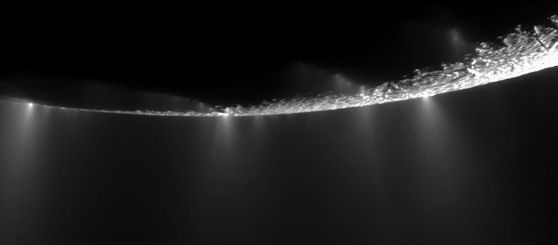| There's a tiny moon orbiting beyond Saturn's rings that's full of promise, and maybe -- just maybe -- microbes. In a series of tantalizingly close flybys to the moon, named 'Enceladus', NASA's Cassini spacecraft has revealed watery jets erupting from what may be a vast underground sea. These jets, which spew through cracks in the moon's icy shell, could lead back to a habitable zone that is uniquely accessible in all the solar system. "More than 90 jets of all sizes near Enceladus's south pole are spraying water vapor, icy particles, and organic compounds all over the place," says Carolyn Porco, an award-winning planetary scientist and leader of the Imaging Science team for NASA’s Cassini spacecraft. "Cassini has flown several times now through this spray and has tasted it. And we have found that aside from water and organic material, there is salt in the icy particles. The salinity is the same as that of Earth's oceans." | Dramatic plumes, both large and small, spray water ice from many locations near the south pole of Saturn's moon Enceladus. More than 30 individual jets of different sizes can be seen in this image captured during a flyby of NASA's Cassini spacecraft on Nov. 21, 2009. |
The watery plumes of Enceladus come from icy fissures nicknamed "tiger stripes." She believes the small moon, with its sub-surface liquid sea, organics, and an energy source, may host the same type of life we find in similar environments on Earth.
To read the whole article, go to http://science.nasa.gov/science-news/science-at-nasa/2012/27mar_enceladus/

 RSS Feed
RSS Feed